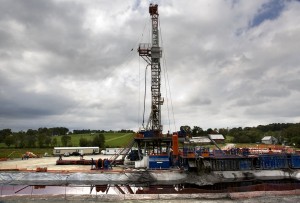Neither “climate” nor “global warming” made it into President Obama’s State of the Union address, but energy policy was front and center. Obama called for a “Clean Electricity Standard” for utilities. So, what’s a CES, and what would it mean for climate?
 The CES concept derives from state “Renewable Energy Standards” that require electric utilities to commit to supply a specified fraction of their power from a menu of renewable sources, including wind, solar, geothermal and hydro, along with “nega-watts” gained by retrofitting homes and businesses. Most RES’s also include less “pure green” elements like biofuels, however.
The CES concept derives from state “Renewable Energy Standards” that require electric utilities to commit to supply a specified fraction of their power from a menu of renewable sources, including wind, solar, geothermal and hydro, along with “nega-watts” gained by retrofitting homes and businesses. Most RES’s also include less “pure green” elements like biofuels, however.
State RES programs appear to have helped renewables gain a foothold on some U.S. grids, though the levels are nowhere near the 19% combined share that wind and solar generation attained in Spain last year. In June 2009, the Senate Energy and Natural Resources Committee approved a bipartisan bill that would have set a national renewable standard rising to 15% by 2021. Environmental groups criticized its weak standard and its provision to increase drilling off the Florida coast. Despite pleas by committee chairman Jeff Bingaman (D-NM), the RES bill never reached the Senate floor.
A White House “fact sheet” released just after Tuesday’s address sketches Obama’s CES. It’s effectively an RES with a watered-down menu that adds nuclear, “clean coal” and natural gas to the options for utilities. The fact sheet doesn’t provide details, but CES isn’t a new concept. Sen. Lindsey Graham circulated a draft CES bill last January that reads like a tamer version of cap-and-trade for the utility sector. Instead of cap-and-trade’s pollution “allowances,” CES’s currency is clean electricity credits. Instead of providing a foothold for renewables as an RES would do, the CES framework would put renewables into competition with (already subsidized) nuclear, (thermodynamically-challenged) “clean coal” (a.k.a. carbon capture and sequestration) and natural gas. It effect, it’s a menu without prices.
Let’s look at the new fuels and technologies that Obama’s CES would add to the RES menu:
Nuclear: Aside from well-documented impacts from uranium mining, reactor accidents, weapons proliferation and radioactive waste, nukes have been handed vast subsidies and allowed to operate by special rules for a half a century. Why should fledgling (and genuinely clean) renewables be made to compete against a favored technology that has never been taken off federal life support?
Clean Coal: It’s a fairy tale. And not just because most coal can’t be mined without leaving a toxic mess or because of the conventional pollutants released by burning coal. “Capturing” CO2, if it can even be done, will require vast amounts of energy, which means mining and burning even more coal for the same desired net output. The thermodynamic minimum to capture CO2 from a coal-fired power plant appears to be a quarter to a third of the energy output. Not surprisingly, carbon capture and sequestration on a commercial scale doesn’t exist anywhere, and its development in the U.S. is overwhelmingly funded by tax dollars — which should tell us something about its viability. While Obama hasn’t spelled out what would qualifiy as “clean” coal, Sen. Graham’s CES proposal set a low standard: coal-fired power plants capturing just 65% of CO2 qualify.
Natural Gas: For decades, this fuel has been looked to as a “transition fuel” from dirtier coal and petroleum — a view that continues today, but which overlooks a few inconvenient truths. Natural gas is methane (CH4), each molecule of which in the atmosphere traps Earth’s heat 72 times as effectively as a molecule of carbon dioxide. Even adjusting for methane’s shorter residence time in the atmosphere, both the IPCC and the U.S. government put the relative 100-year GHG impact of a molecule of methane released to the atmosphere at 25 times that of CO2. While the point is to burn gas as fuel, not release it, gas distribution systems are vast and they leak, with the average U.S. leak rate estimated to be 1.4% or more, a rate that cancels out much of natural gas’s apparent climate advantage over coal. And as many residents of Pennsylvania and New York are learning, the process of extracting gas (“hydrofracking”) from the Marcellus Shale formation underneath their homes and communities can irreparably contaminate ground and surface water.
There’s a larger point to be made here as well. Utility investment in nukes, gas-fired power plants or CCS for coal expands the array of sunk costs that tilts the market toward incumbent fuels and technologies and away from true zero-carbon sources like wind and solar. And of course, the supply of gas isn’t exactly unlimited, even with hydrofracking and Alaska gas pipelines. There are other claims on natural gas as well, such as replacing imported (and higher carbon) oil for fuel in vehicles, as T. Boone Pickens has suggested.
In contrast, a carbon tax, as proposed by Rep. John Larson (D-CT) and former Rep. Bob Inglis (R-SC), would put climate costs on utilities’ energy menu and ensure that their choices reflect those costs. In proportion to their carbon content per unit of energy, coal would be taxed more heavily than oil which would be taxed more than gas, while true renewables like wind and solar would pay no carbon tax and nuclear taxed only indirectly, and modestly, through its fuel cycle. A carbon tax would provide truth in pricing to biofuels, too; the price of ethanol, for example, would reflect its fossil fuel inputs — gas for fertilizer and distillation. A steadily-rising carbon tax would allow utilities to predict an expected rate of return for renewable generation facilities, thus reducing the risk of those investments. While it’s true that a CES would take away some of dirty coal’s price advantage, it wouldn’t spur a steady stream of investment in renewables since they would have to compete against nukes, gas and so-called “clean coal.”
Does Obama’s CES have political legs? Senator Lisa Murkowski, ranking Republican on the Senate Energy and Natural Resources Committee quipped after the State of the Union that “the devil is in the details.” She’s likely to scrutinize how much CES might boost the market for Alaskan gas that would be delivered to the Lower 48 by the Denali and Trans-Canada pipelines. And Sen. Graham surely wants a big slice for nukes. And corn belt Senators will want to further subsidize distilling corn (grown with fertilizer made from natural gas) into ethanol… Whether renewables can eke out anything in that crowd will depend very much on details such as how the “clean energy credits” are allocated. But it’s guaranteed to be far less than the boost to renewables from a straight carbon tax.
Photos: Google Images


Jeanne Fudala says
This is an excellent overview and I’m rather surprised no one else has commented as yet.
Since I’m in the throes of the NY/PA effort to oppose any more high-volume slickwater horizontal hydraulic fracturing, I was particularly pleased with the section on that. I consider to be part of the struggle to mitigate climate change as I see such drilling operations to be a major contributor to heat trapping emissions, contrary to the belief in methane gas as a transition fuel.
In fact this form of drilling has been termed along with such things as shale oil drilling and mountaintop removal as part of the new era of “extreme energy” as efforts become ever more massive to recover every possible drop. James Hansen sums this up well on pp 184-185 of “Storms of My Grandchildren”.
I wish there was a way to better build CO2 equivalents into the carbon tax, especially to directly get at methane–molecules of which do have a carbon atom. CH4
Olivia Fussell says
Agree excellent overview and good points. GHG emissions are a world-wide problem and as such there does need to be a consensus that involves all countries. It is time that the U.S. provided the public with the full picture and did the numbers in a way that can be understood. A carbon tax is one solution, but it is nearby impossible for all countries to calibrate a carbon tax that would be acceptable to all nations individually and collectively, particularly those that have a per capital carbon use of 10 (or less) times that of the US. Let’s face it, the oil, gas and petroleum industry need to continue to supply the nation’s needs, but as James Hansen points out, this is at the expense of the future generations. We must find a way to build a fair cost for CO2e into a mechanism that meets the end game which is to meet GHG reductions as per commitments established and agreed to by the large emitting countries (including China and India). The US needs to face this issue, join the international convention and work out a solution as soon as possible.
James Handley says
Jeanne,
I agree that a carbon tax try to should factor in leakage rates for natural gas, which would more accurately reflect its climate impact and might create incentives to fix some of those leaks.
Olivia,
One advantage of a carbon tax is that when one country or trading bloc sets a carbon tax, it can impose an equivalent carbon price on imported products via WTO-sanctioned border tax adjustments. This “harmonization” would create an incentive for trading partners to enact their own carbon pricing to collect the carbon tax revenues and avoid tariffs on their exports.
If we choose taxes instead of “caps,” a global agreement on targets or allocations isn’t needed — we just need to keep raising the carbon price. Moreover, no agreement and no reductions have been achieved after 13 years of wrangling in the UN. (I doubt it’s possible; an allocation of carbon emissions would amount to a globally-planned economy and every nation would have incentives to cheat.)
In short, if we lead, the world will have good reasons to follow. See Report from Copenhagen: Forget carbon targets, just set a price.
N Hornsby says
Interesting that many people believe that there will be limited impact? Explain this then.
1) Coal fired government run power stations (archaic as they are) pay less than $45 per tonne of coal. Allowing that this calculation should be based on 14000 calories per lb (1 tonne of coal = 3.7 tonnes of CO2) and most power stations burn a lower grade so lets say 3.5 times ratherthan 3.7 for the argument, then coal purchased at say $45 per tonne + 3.5 * $23 by my reckoning lifts the inclusive coal price to $125.50 or more than 150% its current cost.
2) If the cost of coal for smelting (Aprox >$100 per tonne) adding in the Carbon Tax will put the price to $185
or an 85% increase in the cost of goods.
The government might subsidise the retail consumer, however steel and other metal producers will shut down and import. Its a simple matter of produce it onshore at one cost, if its cheaper offshore you import it.
Good luck with the minimal effect.